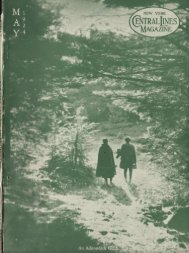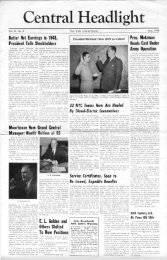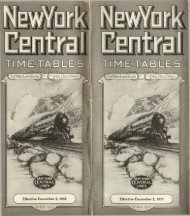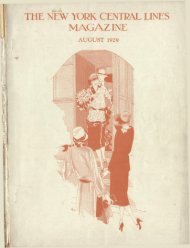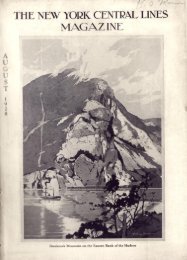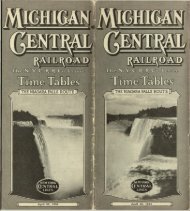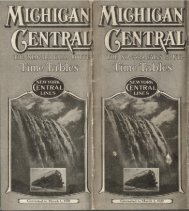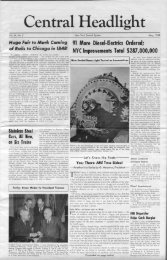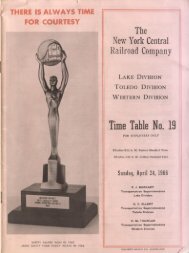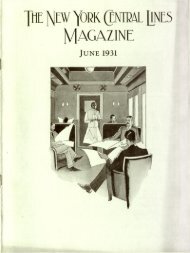You also want an ePaper? Increase the reach of your titles
YUMPU automatically turns print PDFs into web optimized ePapers that Google loves.
86 New York Central Lines Magazine for May, 1928<br />
A<br />
What the Kadi© Manufacturers Offer<br />
i^The Freed^Eiseinan NM^60<br />
FEW days ago a prospective<br />
member of the Order of Radio<br />
Fans asked the writer, "What<br />
constitutes a good radio?"<br />
I promptly answered, "A radio set<br />
in order to be called good must have<br />
selectivity, sensitivity and good tonal<br />
quality."<br />
This did not satisfy the questioner<br />
and lo and behold, he popped the question<br />
all radio men are trying to dodge,<br />
"What is the best radio set?"<br />
That is a hard one to answer. As<br />
a matter of fact I would say that it is<br />
impossible to answer it truthfully. A<br />
better question would be, "What sets<br />
do you consider<br />
good that cost<br />
around $100 (or<br />
whatever price you<br />
mi ght want to<br />
spend).<br />
But so far as the<br />
best set in radio—•<br />
there is no such<br />
set. Your set,<br />
your neighbor's set,<br />
your best friend's<br />
set, each is the<br />
"best" set in radio<br />
today. Whether it<br />
cost $50 or $500,<br />
it's the best set because<br />
it's yours.<br />
In this article<br />
(which is the first<br />
of a series) I am<br />
going to give the<br />
results of a test<br />
given to the new<br />
Freed - Eiseman<br />
NR-60 electric set. This is one of the<br />
good sets that cost $160. The photograph<br />
shows the set with a Peerless<br />
speaker. Freed-Eiseman is to be congratulated<br />
on turning out such a set<br />
as this one. Model NR-60 is a onecsntrol<br />
receiver that has selectivity,<br />
sensitivity and excellent tonal quality.<br />
The cabinet is made of mahogany and<br />
is of a very neat design that will harmonize<br />
with almost any living room.<br />
The power unit is contained in the<br />
cabinet with the set and is designed so<br />
that it does not affect the efficiency of<br />
the receiver. Both set and power unit<br />
are completely shielded.<br />
The big feature of the NR-60 is a<br />
device called an inductor (which is a<br />
tapped variometer) that aids the set<br />
owner in eliminating interference on<br />
Freed-Eiseman NR-60 electric set with Peerless speaker<br />
the low waves and is a big help when<br />
searching for distant stations. Using<br />
an aerial of 100 feet in length all locals<br />
were logged, with stations in<br />
Pittsburgh, Baltimore, Atlantic City,<br />
Springfield and Philadelphia, while<br />
the numerous local New York stations<br />
were broadcasting. At 10:30 P.M.,<br />
real distance started coming through.<br />
Antennae of different lengths were<br />
tried and the set still worked efficiently.<br />
On a strip of wire ten feet in<br />
length Nashville was logged.<br />
The Peerless speaker used while<br />
testing this outfit worked excellently.<br />
No matter how much volume was<br />
turned on, the speaker retained its<br />
sweet and mellow qualities. Inside<br />
this speaker is a filter which protects<br />
the speaker. The Peerless costs $35.<br />
CeCo tubes were used during the<br />
period of test and are recommended by<br />
this department. The CeCo tubes on<br />
test have given longer life than any<br />
other tubes tested.<br />
An interesting experiment was tried<br />
on the NR-60. The ground connection<br />
used was attached to a radiator<br />
about ten feet away from the set. Another<br />
ground was connected to the receiver<br />
and louder signals were received<br />
on distant stations. Eight ground<br />
connections were used in all, which<br />
increased the range of the receiver.<br />
Next month—The Steinite Electric<br />
Set.<br />
Laboratory<br />
Notes<br />
V E R Y good<br />
cure for a motor-boatingreceiver<br />
is to use an<br />
Eveready Layerbilt<br />
battery in connection<br />
with the B<br />
eliminator. The<br />
B-minus of the B<br />
battery should be<br />
connected to the<br />
B-m i n u s of the<br />
eliminator. The detector<br />
voltage<br />
should be taken<br />
from the B battery<br />
and not from the<br />
eliminator. The<br />
Layerbilt Eveready<br />
battery _ is<br />
recommended because of its long life.<br />
These batteries are constructed differently<br />
from any other battery on the<br />
market today. The cells instead of<br />
being cylindrical are flat or layer<br />
built, one on top of each other. Their<br />
life exceeds that of most heavy duty<br />
batteries.<br />
There has been a question in the<br />
minds of some radio fans as to whether<br />
an automobile six-volt battery could<br />
be used as a radio A battery. A<br />
Gould automobile battery has been<br />
connected to a radio set in the laboratory<br />
and results have been excellent<br />
so far. The battery has been connected<br />
only for two weeks. See next<br />
month's laboratory notes for further<br />
results.<br />
The 1928 Centrola (five or six<br />
New York Central Lines Magazine for May, 1928<br />
87<br />
tubes) is quite a receiver. Distant<br />
stations have been received on an Ail "A" Eliminator That Every Fan Can Build<br />
;ierial forty feet in length. The July ACHAT'S the matter, Joe, why 29 Drilled Base Board.<br />
issue will give full details on this set. W , „, 30 Metal Cover.<br />
*<br />
This department is only too glad<br />
to answer questions pertaining to<br />
your radio set, but please give full<br />
details such as make of set, circuit<br />
employed (if you know it), number<br />
of tubes, kind of tubes, age of your<br />
tubes, length of aerial, kind of wire<br />
used on aerial, age of the aerial, kind<br />
of batteries used and age of batteries.<br />
Have you had the set repaired at any<br />
time? To what is your ground connected?<br />
Write in your troubles and<br />
we'll try to help. Also write in your<br />
experiences, so they can be told to<br />
other readers.<br />
v<br />
SO glum.' 3 1 A c Line Attachment Cord with Plugs.<br />
"Well, the storage battery that be- 32 Output Cord for connecting to set with<br />
I<br />
For The Good of Radio<br />
T is just around this time of the<br />
year that radio fans will start<br />
hearing, "This is the last of the<br />
Iodine hours for this season. The<br />
Iodine Company, sponsors of these enjoyable<br />
Iodine hours, will be back on<br />
the air the second week of September.<br />
Until then the Iodine Company (sponsors<br />
of the Iodine hour) bid you all<br />
farewell."<br />
Each year this happens. Toward<br />
the end of May and during the first<br />
few weeks of June many sponsors of<br />
these programs sign off until September.<br />
And then there is so much good<br />
entertainment that you miss half of it.<br />
Now there is a remedy for this falling<br />
off of these hours, and the radio<br />
fan himself can be the doctor. Here's<br />
the cure: Write to the stations to<br />
which you listen and tell them that<br />
you would like to hear the Iodine hour<br />
during the summer months.<br />
Get all your friends to write in to<br />
the different stations. These letters<br />
are always forwarded to the sponsors<br />
of these hours. The reason, according<br />
to the donors of these programs, that<br />
these hours are discontinued is that<br />
fans don't "listen in" during the hot'<br />
weather.<br />
In a way you can't blame the manufacturer<br />
who supports the program<br />
for feeling that way, as he receives<br />
very few letters of encouragement.<br />
It's up to the set owner, so now,<br />
go to it! Get your pen out and write<br />
a letter today to the sponsors of the<br />
hours that you enjoy. Tell everybody<br />
to write. It's for your pleasure and<br />
also for the good of radio.<br />
Next month a four-tube portable set<br />
will be described. This set can be used<br />
with 201-A tubes or the 199 type. Not<br />
alone is this outfit good as portable,<br />
but it can be used as set for the living<br />
room.<br />
Free Booklet<br />
An interesting booklet may be obtained<br />
from Electrad, 175 Varick<br />
Street, New York City, free of charge<br />
by writing and mentioning the New<br />
York Central Lines Magazine.<br />
This booklet gives the popular B<br />
eliminators and power amplifiers of<br />
today. It is called "What B Eliminator<br />
Should I Build?"<br />
longs to my radio went 'west' last 3 3 F 1 S 1 5 wire.<br />
night and I have to get another bat- * * *<br />
tery. But do you know that I hate The smaller parts come in envelopes<br />
to buy another one. I'm tired of o n -which are printed the contents,<br />
charging it and adding water and item number and on which parts the<br />
having all that muss that goes with a contents are to be used.<br />
wet 'A' battery." J} 0 not attempt to open all envelopes<br />
"I had the same experience myself, and then pick parts at random; rather<br />
Joe, about a month ago and I bought follow instructions and assemble each<br />
myself an 'A' eliminator that is abso- individual sub-assembly at one time.<br />
lutely dry, requires no water, and op- if the metal cover touches the AC<br />
erates without the slightest hum." pi ug connector, it should be insulated<br />
"You see, Jack, I was afraid to get by means of a piece of cardboard cut<br />
one of those devices because I didn't to fit over the prongs of the AC conknow<br />
how efficient they were. What nector. This is important, as if it<br />
kind have you?" touches there may be a short circuit.<br />
"It's a Knapp 'A' eliminator and it if the connections are made corcomes<br />
in kit form. I assembled it in rectly you will find that your receiver<br />
about ninety minutes and it was a i s ready for immediate operation on<br />
cinch. First time I ever tackled any- the throw of the toggle switch. This<br />
thing like that, but I took my time, switch also controls a "B" eliminator,<br />
checked up all connections carefully which may be plugged into the top<br />
and before I knew it I was finished connection. The unit works equally<br />
with it." well with "B" batteries or an elim-<br />
"That seems to be a good bet. Think inator.<br />
I'll get one. But wait; you know I When tuning the set on or off use<br />
have an eight-tube set. Will it work the switch on the Knapp "A" power,<br />
an outfit with that many tubes?" Leave your switch on your set "on"<br />
"Sure it will! Take down the address at all times and throw the switch of<br />
of the firm that manufactures these the eliminator to start or stop the set.<br />
kits. It's the Knapp Electric Cor- The resistance unit and top plate<br />
poration, Port Chester, New York." switch are used to supply the proper<br />
So Jack bought an "A" eliminator "A" voltage for all receivers up to<br />
kit and upon opening it found thirty- eight tubes. If the flexible plug conthree<br />
parts, each tagged with its item nector is placed on stud 1, then the<br />
number for identification. The parts lowest available voltage and current<br />
a r<br />
e: are obtained; and in like fashion maximum<br />
output is realized where the plug<br />
Item Name Symbol j s inserted in post 8. For best results<br />
1 Transformer A a re]i able voltmeter should then be<br />
2 Rectifier Unit R tried until the voltmeter reads 6, when<br />
Condenser<br />
C a p a C<br />
t y<br />
'<br />
. .. C-l all tube filaments of the receiver are<br />
4 Choke Coil with 6 brass spacers L-l burning. A 6-volt supply is correct<br />
5 Special high capacity "A" Power for all sets employing 201-A, 112 and<br />
Condenser C-2 171 type tubes. After this adjust-<br />
6 Choke Coil — .......1^-2 ment has been found no further volt-<br />
7<br />
8<br />
Drill Base Plate (Copper"d<br />
Drilled Top Plate (Brown Bakelite with<br />
studs in place).<br />
m 6 t e r<br />
°J /"enticm to the<br />
POWer unit IS needed.<br />
For small sets, say those using<br />
9 Contact Plate (with mounting bracket). three or four tubes, it may be neces-<br />
10 Transformers<br />
and Nuts<br />
Mounting Screws s a ry to install a 6 or 10-ohm rheostat<br />
. Envelope No. 1 j n t h g „ A„ m i n u g j e a (j g 0 t<br />
1 1<br />
"stews 0<br />
( L " .<br />
1 )<br />
.-.<br />
. MOUnt<br />
EnvelopeNo. 2 reduce the output voltage to 6.<br />
12 Rectifier Fastening Nuts.. Envelope No. 3<br />
13 Nuts for fastening wire to rec- Whv Not a Tnne GnntrnlO<br />
tifier on underneath side of V»uy i>Ol a lone control.<br />
14<br />
t 0<br />
a t e<br />
P P'<br />
Plug for "B" Eliminator<br />
Envelope No. 4<br />
Envelope No. 5<br />
» . t<br />
WW<br />
E bear much ree-ardine- a suit-<br />
, , mucn regaramg a suit<br />
t t<br />
15<br />
16<br />
Nuts for holding Transformer<br />
Top Leads Envelope No. 6<br />
Screws and Washers for mounty<br />
7<br />
able volume control, but very<br />
little about a tone control. Yet the<br />
j a e r i g a l m o s t a s important as the<br />
ing Choke Coil (L-l) to Top m .<br />
Plate Envelope No. 7 former. There are times when we<br />
17 Screws and Spacers for mount- want sharp, crisp reproduction, such<br />
ing Transformer to Top « , i j i • i<br />
Pl| t e Envelope No. 8<br />
a s f o r<br />
speeches, band and jazz selects<br />
H & H Toggle Switch... Envelope No. 9 tions, and weak signals, while at other<br />
19 Screws, Nuts and Washers for times we want mellow, soft, entranc-<br />
mountmg Contact Plate to . , . , ,<br />
Top Plate Envelope No. io m<br />
20<br />
21<br />
2 2<br />
S vocal and instrumental rendition.<br />
Terminals EnvelopeNo.il A tone control, therefore, is necessary<br />
Condenser Mounting Bracket to remove the higher frequencies<br />
Screws Envelope No. 12 which are responsible for the sharp,<br />
"str e<br />
ew?^ (L<br />
: 2)<br />
. MOUntm<br />
23<br />
24<br />
25<br />
n d<br />
lnve.opeNo.i3 f»*p/ ^ / disagreeable quall<br />
t y o f s o m e<br />
Bottom Plate Mounting loudspeakers. The Sim-<br />
Screws Envelope No. 14 piest tone control comprises a volume<br />
Nuts and Washers for Ter- control clarostat in series with a Vi<br />
minal Posts Envelope No. 15 condenser, the combinations<br />
Resistance Umt Envelope No. 16 being shunted across the loudspeaker<br />
26 bwitch Post Connector. . . Envelope No. 17 - j ! m • i . ,, r<br />
27<br />
,<br />
Screws for fastening metal cover XTl<br />
V^t- Turning the knob of the clar*<br />
to Base Board Envelope No. 18 stat serves to increase or decrease<br />
28 Condenser Mounting Brackets. sharpness.





